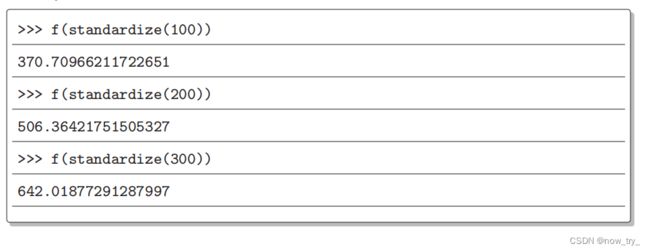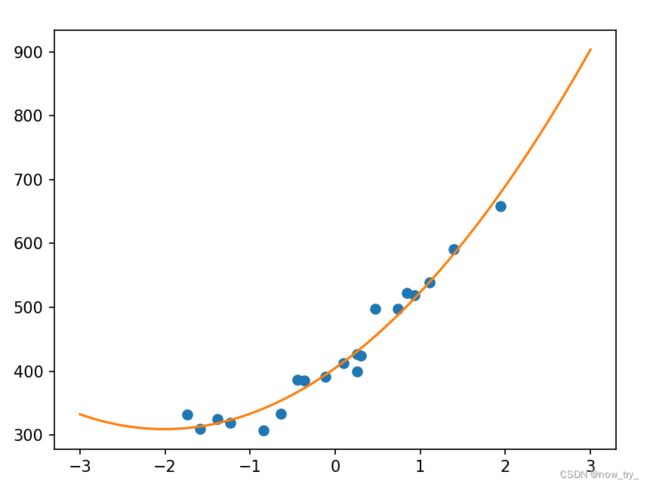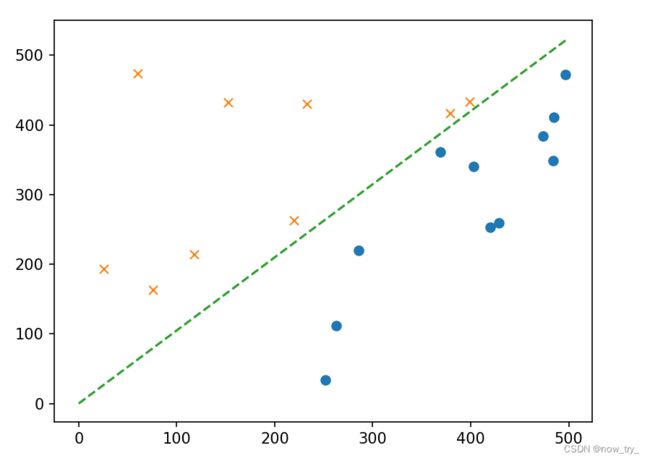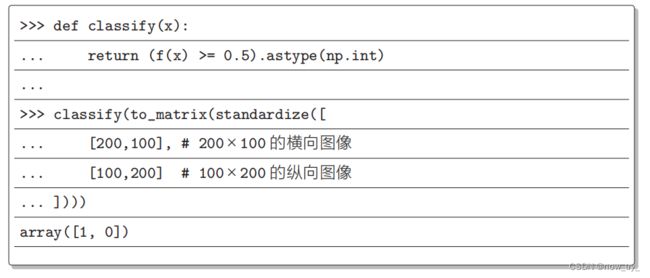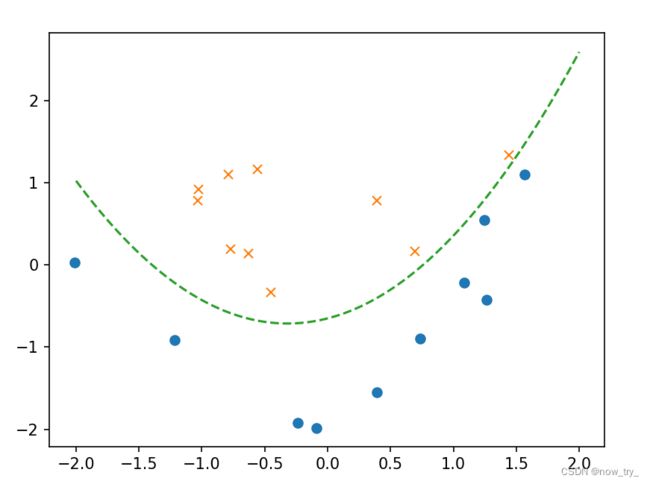深度学习入门---《白话机器学习的数学》笔记
文章目录
-
- 一、基础:回归的实现
-
-
- 1、训练数据click.csv
- 2、参考公式:
- 3、代码实现:
- 4、运行结果:
- 5、验证:
-
- 二、多项式回归
-
-
- 1、参考公式
- 2、代码实现
- 3、运行结果
-
- 三、随机梯度下降法的实现
-
-
- 1、参考公式
-
- 小批量(mini-batch)梯度下降法
- 2、代码实现
- 3、运行结果
-
- 四、感知机
-
-
- 1、训练数据images1.csv
- 2、参考公式
-
- 感知机模型
- 判别函数
- 权重向量的更新表达式
- 3、代码实现
- 4、运行结果
- 5、验证
-
- 五、分类——逻辑回归的实现
-
-
- 1、训练数据images2.csv
- 2、参考公式
-
- sigmoid函数
- 参数更新表达式
- 3、代码实现
- 4、运行结果
- 5、验证
-
- 六、线性不可分分类的实现
-
-
- 1、训练数据data3.csv
- 2、代码实现
- 3、运行结果
-
- 绘制精度上升曲线
- 4、用随机梯度下降法实现
-
- 七、正则化
-
-
- 1、准备工作
- 2、代码实现
- 3、运行结果
-
- 未应用正则化的实现
- 应用了正则化的实现
-
一、基础:回归的实现
1、训练数据click.csv
x,y
235,591
216,539
148,413
35,310
85,308
204,519
49,325
25,332
173,498
191,498
134,392
99,334
117,385
112,387
162,425
272,659
159,400
159,427
59,319
198,522
2、参考公式:
首先把 fθ(x) 作为一次函数来实现

参数更新表达式:

学习率先设置为10−3 。
3、代码实现:
'''
回归的实现
'''
import numpy as np
import matplotlib.pyplot as plt
# 读入训练数据
train = np.loadtxt('click.csv',delimiter=',',skiprows=1)
train_x = train[:,0]
train_y = train[:,1]
# 参数初始化
theta0 = np.random.rand()
theta1 = np.random.rand()
# 预测函数
def f(x):
return theta0 + theta1 * x
# 目标函数
def E(x,y):
return 0.5 * np.sum((y - f(x))**2)
# 标准化
mu = train_x.mean()
sigma = train_x.std()
def standardize(x):
return (x - mu)/sigma
train_z = standardize(train_x)
# 绘图
# plt.plot(train_z,train_y,'o')
# plt.show()
# 学习率
ETA = 1e-3
# 误差的差值
diff = 1
# 更新次数
count = 0
# 直到误差的值小于0.01为止,重复参数更新
error = E(train_z, train_y)
while diff > 1e-2:
# 更新结果保存到临时变量
tmp0 = theta0 - ETA * np.sum((f(train_z) - train_y))
tmp1 = theta1 - ETA * np.sum((f(train_z) - train_y) * train_z)
# 更新参数
theta0 = tmp0
theta1 = tmp1
# 计算与上一次误差的差值
current_error = E(train_z,train_y)
diff = error - current_error
error = current_error
# 输出日志
count += 1
log = '第{}次:theta0 = {:.3f},theta1 = {:.3f},差值 = {:.4f}'
# print(log.format(count,theta0,theta1,diff))
# 绘图确认
x = np.linspace(-3, 3, 100)
plt.plot(train_z,train_y,'o')
plt.plot(x,f(x))
# plt.show()
# print(f(standardize(100)))
4、运行结果:
5、验证:
二、多项式回归
提示:增加参数theta2,并替换预测函数
多重回归:将参数和训练数据都作为向量来处理,使计算变得简单
1、参考公式
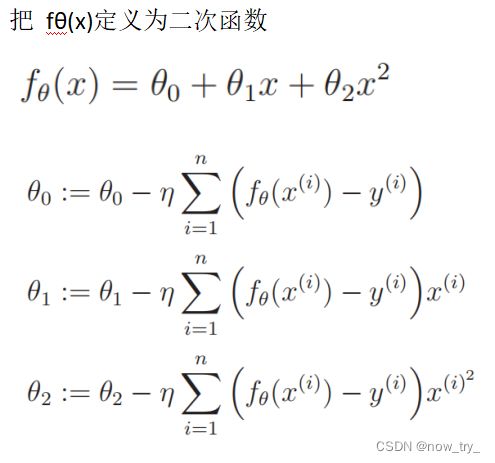
将参数和训练数据都作为向量来处理,可以使计算变得更简单

由于训练数据有很多,所以我们把 1 行数据当作 1 个训练数据,以矩阵的形式来处理会更好

2、代码实现
'''
多项式回归
增加参数theta2,并替换预测函数
多重回归:将参数和训练数据都作为向量来处理,使计算变得简单
'''
import numpy as np
import matplotlib.pyplot as plt
# 读入训练数据
train = np.loadtxt('click.csv',delimiter=',',skiprows=1)
train_x = train[:,0]
train_y = train[:,1]
# 标准化
mu = train_x.mean()
sigma = train_x.std()
def standardize(x):
return (x - mu)/sigma
train_z = standardize(train_x)
# 初始化参数
theta = np.random.rand(3)
# 学习率
ETA = 1e-3
# 误差的差值
diff = 1
# 均方误差的历史记录
errors = []
# 创建训练数据的矩阵
def to_matrix(x):
return np.vstack([np.ones(x.shape[0]),x,x ** 2]).T
X = to_matrix(train_z)
# 预测函数
def f(x):
return np.dot(x,theta)
# 目标函数
def E(x,y):
return 0.5 * np.sum((y - f(x))**2)
# 均方误差
def MSE(x, y):
return (1 / x.shape[0]) * np.sum((y - f(x)) ** 2)
# 重复学习
error = E(X, train_y)
errors.append(MSE(X, train_y))
while diff > 1e-2:
# 更新参数
theta = theta - ETA * np.dot(f(X) - train_y,X)
# 计算与上一次误差的差值
current_error = E(X, train_y)
diff = error - current_error
error = current_error
errors.append(MSE(X, train_y))
# diff = errors[-2] - errors[-1]
# 绘制拟合曲线
x = np.linspace(-3,3,100)
plt.plot(train_z,train_y,'o')
plt.plot(x,f(to_matrix(x)))
plt.show()
# 绘制误差变化图
x = np.arange(len(errors))
plt.plot(x, errors)
plt.show()
3、运行结果
三、随机梯度下降法的实现
1、参考公式
在随机梯度下降法中会随机选择一个训练数据并使用它来更新参数。表达式中的 k 就是被随机选中的数据索引。

随机梯度下降法由于训练数据是随机选择的,更新参数时使用的又是选择数据时的梯度,所以不容易陷入目标函数的局部最优解。
小批量(mini-batch)梯度下降法
前面提到了随机选择 1 个训练数据的做法,此外还有随机选择 m 个训练数据来更新参数的做法。设随机选择 m 个训练数据的索引的集合为 K:

2、代码实现
"""
随机梯度下降法的实现
"""
import numpy as np
import matplotlib.pyplot as plt
# 读入训练数据
train = np.loadtxt('click.csv',delimiter=',',skiprows=1)
train_x = train[:,0]
train_y = train[:,1]
# 标准化
mu = train_x.mean()
sigma = train_x.std()
def standardize(x):
return (x - mu)/sigma
train_z = standardize(train_x)
# 初始化参数
theta = np.random.rand(3)
# 均方误差的历史记录
errors = []
# 误差的差值
diff = 1
# 学习率
ETA = 1e-3
# 创建训练数据的矩阵
def to_matrix(x):
return np.vstack([np.ones(x.shape[0]),x,x ** 2]).T
X = to_matrix(train_z)
# 预测函数
def f(x):
return np.dot(x,theta)
# 目标函数
def E(x,y):
return 0.5 * np.sum((y - f(x))**2)
# 均方误差
def MSE(x, y):
return (1 / x.shape[0]) * np.sum((y - f(x)) ** 2)
# 重复学习
errors.append(MSE(X, train_y))
while diff > 1e-2:
# 为了调整训练数据的顺序,准备随机的序列permutation
p = np.random.permutation(X.shape[0])
# 随机取出训练数据,使用随机梯度下降法更新参数
for x,y in zip(X[p,:],train_y[p]):
theta = theta - ETA * (f(x) - y) * x
# 计算与上一次误差的差值
errors.append(MSE(X, train_y))
diff = errors[-2] - errors[-1]
x = np.linspace(-3,3,100)
plt.plot(train_z,train_y,'o')
plt.plot(x,f(to_matrix(x)))
plt.show()
3、运行结果
四、感知机
1、训练数据images1.csv
x1,x2,y
153,432,-1
220,262,-1
118,214,-1
474,384,1
485,411,1
233,430,-1
369,361,1
484,349,1
429,259,1
286,220,1
399,433,-1
403,340,1
252,34,1
497,472,1
379,416,-1
76,163,-1
263,112,1
26,193,-1
61,473,-1
420,253,1
2、参考公式
感知机模型
判别函数
根据参数向量 x 来判断图像是横向还是纵向的函数,即返回 1 或者 −1 的函数 fw(x)的定义如下。

内积是衡量向量之间相似程度的指标。结果为正,说明二者相似;为 0 则二者垂直;为负则说明二者不相似。
权重向量的更新表达式
3、代码实现
使权重向量成为法线向量的直线方程是内积为 0 的 x 的集合。所以对它进行移项变形,最终绘出以下表达式的图形即可。

"""
分类---感知机
"""
import numpy as np
import matplotlib.pyplot as plt
# 读入训练数据
train = np.loadtxt('images1.csv',delimiter=',',skiprows=1)
train_x = train[:,0:2]
train_y = train[:,2]
# print(list(zip(train_x,train_y)))
# 权重初始化
# 返回一个或一组服从“0~1”均匀分布的随机样本值。随机样本取值范围是[0,1),不包括1
w = np.random.rand(2)
#判别函数
def f(x):
if np.dot(w,x) >= 0:
return 1
else:
return -1
# 重复次数
epoch = 10
# 更新次数
count = 0
# 学习权重
for _ in range(epoch):
for x,y in zip(train_x,train_y):
if f(x) != y:
w = w + y * x
# 输出日志
count += 1
print("第{}次:w = {}".format(count,w))
# 绘制直线:使权重向量称为法线向量的直线方程是内积为0的x的集合
x1 = np.arange(0,500)
plt.plot(train_x[train_y == 1,0], train_x[train_y == 1,1],'o')
plt.plot(train_x[train_y == -1,0], train_x[train_y == -1,1],'x')
plt.plot(x1, -w[0]/w[1]*x1,linestyle = 'dashed')
# plt.axis('scaled')
# plt.show()
print(f([200,100]))
4、运行结果
5、验证
五、分类——逻辑回归的实现
1、训练数据images2.csv
x1,x2,y
153,432,0
220,262,0
118,214,0
474,384,1
485,411,1
233,430,0
369,361,1
484,349,1
429,259,1
286,220,1
399,433,0
403,340,1
252,34,1
497,472,1
379,416,0
76,163,0
263,112,1
26,193,0
61,473,0
420,253,1
2、参考公式
与感知机的不同之处在于,逻辑回归是把分类作为概率来考虑的。
sigmoid函数
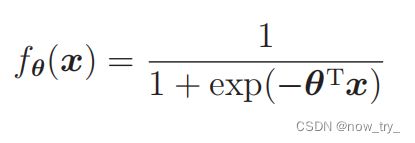

决策边界:
从图中可以看出在 fθ(x) ⩾ 0.5 时,θTx ⩾ 0,反过来在 fθ(x) < 0.5 时,θTx < 0;

参数更新表达式
3、代码实现
首先初始化参数,然后对训练数据标准化。x1和 x2 要分别标准 化。另外不要忘了加一个 x0 列。
θTx = 0这条直线是决策边界
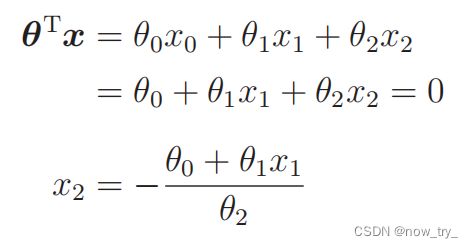
"""
分类:逻辑回归的实现
"""
import numpy as np
import matplotlib.pyplot as plt
# 读入训练数据
train = np.loadtxt('images2.csv',delimiter=',',skiprows=1)
train_x = train[:,0:2]
train_y = train[:,2]
# 初始化参数
theta = np.random.rand(3)
# 标准化:对x1和x2分别取平均值和标准差,进行标准化
mu = train_x.mean(axis = 0)
sigma = train_x.std(axis = 0)
def standardize(x):
return (x - mu)/sigma
train_z = standardize(train_x)
# 增加x0
def to_matrix(x):
x0 = np.ones([x.shape[0], 1])
return np.hstack([x0, x])
X = to_matrix(train_z)
# sigmoid函数
def f(x):
return 1/(1 + np.exp(-np.dot(x, theta)))
# 学习率
ETA = 1e-3
# 重复次数
epoch = 5000
# 更新次数
count = 0
# 重复学习
for _ in range(epoch):
theta = theta - ETA * np.dot(f(X) - train_y, X)
# 日志输出
count += 1
print('第{}次:theta = {}'.format(count,theta))
# 验证:对预测数据进行标准化
# f(to_matrix(standardize([
# [200,100], # 200x100的横向图像
# [100,200] # 100x200的纵向图像
# ])))
def classify(x):
return (f(x) >= 0.5).astype(np.int)
rst = classify(to_matrix(standardize([
[200,100], # 200x100的横向图像
[100,200] # 100x200的纵向图像
])))
# print(rst)
x1 = np.linspace(-2,2,100)
# 将标准化后的训练数据画成图
plt.plot(train_z[train_y == 1, 0], train_z[train_y == 1, 1], 'o')
plt.plot(train_z[train_y == 0, 0], train_z[train_y == 0, 1], 'x')
plt.plot(x1, -(theta[0] + theta[1] * x1) / theta[2], linestyle = "dashed")
plt.show()
4、运行结果
5、验证
六、线性不可分分类的实现
1、训练数据data3.csv
x1,x2,y
0.54508775,2.34541183,0
0.32769134,13.43066561,0
4.42748117,14.74150395,0
2.98189041,-1.81818172,1
4.02286274,8.90695686,1
2.26722613,-6.61287392,1
-2.66447221,5.05453871,1
-1.03482441,-1.95643469,1
4.06331548,1.70892541,1
2.89053966,6.07174283,0
2.26929206,10.59789814,0
4.68096051,13.01153161,1
1.27884366,-9.83826738,1
-0.1485496,12.99605136,0
-0.65113893,10.59417745,0
3.69145079,3.25209182,1
-0.63429623,11.6135625,0
0.17589959,5.84139826,0
0.98204409,-9.41271559,1
-0.11094911,6.27900499,0
2、代码实现
这个数据看上去不能用一条直线来分类,要用二次函数
对于有4个参数的公式变形:
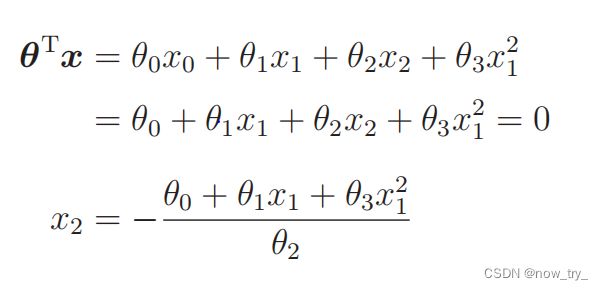
"""
线性不可分分类的实现
"""
import numpy as np
import matplotlib.pyplot as plt
# 读入训练数据
train = np.loadtxt('data3.csv',delimiter=',',skiprows=1)
train_x = train[:,0:2]
train_y = train[:,2]
# 参数初始化
theta = np.random.rand(4)
# 标准化:对x1和x2分别取平均值和标准差,进行标准化
mu = train_x.mean(axis = 0)
sigma = train_x.std(axis = 0)
def standardize(x):
return (x - mu)/sigma
train_z = standardize(train_x)
# 数据看上去确实不能用一条直线来分类,要用二次函数,在训练数据里加上 x1的平方 就能很好地分类了。
# 增加x0和x3
def to_matrix(x):
x0 = np.ones([x.shape[0], 1])
# 增加维度:np.newaxis 放在哪个位置,就会给哪个位置增加维度
# x[:, np.newaxis] ,放在后面,会给列上增加维度
x3 = x[:,0,np.newaxis] ** 2
return np.hstack([x0, x, x3])
X = to_matrix(train_z)
# sigmoid函数
def f(x):
return 1/(1 + np.exp(-np.dot(x, theta)))
def classify(x):
return (f(x) >= 0.5).astype(np.int64)
# 学习率
ETA = 1e-3
# 重复次数
epoch = 5000
# 更新次数
count = 0
# 将重复次数作为横轴,精度作为纵轴来绘图,可以看到精度上升
# 精度的历史记录
accuracies = []
# 重复学习
for _ in range(epoch):
theta = theta - ETA * np.dot(f(X) - train_y, X)
# 日志输出
count += 1
# print('第{}次:theta = {}'.format(count,theta))
# 计算现在的精度
result = classify(X) == train_y
accurancy = len(result[result == True]) / len(result)
accuracies.append(accurancy)
# 将精度画成图
x = np.arange(len(accuracies))
plt.plot(x,accuracies)
plt.show()
# 将结果画成图
x1 = np.linspace(-2, 2, 100)
x2 = -(theta[0] + theta[1]*x1 + theta[3] * x1 ** 2)/theta[2]
plt.plot(train_z[train_y == 1, 0], train_z[train_y == 1, 1], 'o')
plt.plot(train_z[train_y == 0, 0], train_z[train_y == 0, 1], 'x')
plt.plot(x1,x2,linestyle='dashed')
# plt.show()
3、运行结果
绘制精度上升曲线
4、用随机梯度下降法实现
"""
随机梯度下降法的实现
"""
import numpy as np
import matplotlib.pyplot as plt
# 读入训练数据
train = np.loadtxt('data3.csv',delimiter=',',skiprows=1)
train_x = train[:,0:2]
train_y = train[:,2]
# 参数初始化
theta = np.random.rand(4)
# 标准化:对x1和x2分别取平均值和标准差,进行标准化
mu = train_x.mean(axis = 0)
sigma = train_x.std(axis = 0)
def standardize(x):
return (x - mu)/sigma
train_z = standardize(train_x)
# 增加x0和x3
def to_matrix(x):
x0 = np.ones([x.shape[0], 1])
# 增加维度
x3 = x[:,0,np.newaxis] ** 2
return np.hstack([x0, x, x3])
X = to_matrix(train_z)
print(X)
# sigmoid函数
def f(x):
return 1/(1 + np.exp(-np.dot(x, theta)))
def classify(x):
return (f(x) >= 0.5).astype(np.int64)
# 学习率
ETA = 1e-3
# 重复次数
epoch = 5000
# 更新次数
count = 0
# 将重复次数作为横轴,精度作为纵轴来绘图,可以看到精度上升
# 精度的历史记录
accuracies = []
# 重复学习
for _ in range(epoch):
# 使用随机梯度下降法更新参数
p = np.random.permutation(X.shape[0])
for x,y in zip(X[p,:], train_y[p]):
theta = theta - ETA * (f(x) - y)*x
# 将结果画成图
x1 = np.linspace(-2, 2, 100)
x2 = -(theta[0] + theta[1]*x1 + theta[3] * x1 ** 2)/theta[2]
plt.plot(train_z[train_y == 1, 0], train_z[train_y == 1, 1], 'o')
plt.plot(train_z[train_y == 0, 0], train_z[train_y == 0, 1], 'x')
plt.plot(x1,x2,linestyle='dashed')
plt.show()
# Iris 数据集也可以用在分类上,可以用它进行更多尝试
七、正则化
1、准备工作
自定义函数,并加入一些噪声数据:
 虚线就是正确的 g(x) 的图形,圆点就是加入了一点噪声的训练数据:
虚线就是正确的 g(x) 的图形,圆点就是加入了一点噪声的训练数据:

假设用 10 次多项式来学习这个训练数据。10 次多项式,包括参数 θ0 在内,一共有 11 个参数。
2、代码实现
"""
正则化的实现
"""
import numpy as np
import matplotlib.pyplot as plt
# 真正的函数
def g(x):
return 0.1 * (x ** 3 + x ** 2 + x)
# 随意准备一些向真正的函数加入了一点噪声的训练数据
train_x = np.linspace(-2,2,8)
train_y = g(train_x) + np.random.randn(train_x.size) * 0.05
# 标准化
mu = train_x.mean(axis = 0)
sigma = train_x.std(axis = 0)
def standardize(x):
return (x - mu)/sigma
train_z = standardize(train_x)
# 创建训练数据的矩阵,假设我们用 10 次多项式来学习这个训练数据。
# 按垂直方向(行顺序)堆叠数组构成一个新的数组.堆叠的数组需要具有相同的维度
def to_matrix(x):
return np.vstack([
np.ones(x.size),
x,
x ** 2,
x ** 3,
x ** 4,
x ** 5,
x ** 6,
x ** 7,
x ** 8,
x ** 9,
x ** 10,
]).T
X = to_matrix(train_z)
# 参数初始化
# X.shape[1]:有几列
# randn是从标准正态分布中返回一个或多个样本值。正态分布,也即这些随机数的期望为0,方差为1;
# rand则会产生[0, 1)之间的随机数
theta = np.random.randn(X.shape[1])
# 预测函数
def f(x):
return np.dot(x, theta)
# 绘图确认
x = np.linspace(-2,2,100)
# plt.plot(train_x,train_y,'o')
# plt.plot(x,g(x),linestyle='dashed')
# plt.ylim(-1,2)
# plt.show()
# 学习率
ETA = 1e-4
# 误差
diff1 = 1
# 目标函数
def E(x,y):
return 0.5 * np.sum((y - f(x)) ** 2)
# 重复学习
error = E(X, train_y)
'''不应用正则化的实现'''
''''''
while diff1 > 1e-6:
theta = theta - ETA * np.dot(f(X)-train_y,X)
current_error1 = E(X, train_y)
diff1 = error - current_error1
error = current_error1
z = standardize(x)
plt.plot(train_z,train_y,'o')
plt.plot(z, f(to_matrix(z)),linestyle='dashed')
plt.show()
'''应用了正则化的实现'''
'''
# 保存未正则化的参数,然后再次参数初始化
theta1 = theta
theta = np.random.randn(X.shape[1])
# 正则化常量
LAMBDA = 1
# 误差
diff2 = 1
while diff2 > 1e-6:
# 正则化项。偏置项不适用正则化,所以为0
reg_term = LAMBDA * np.hstack([0,theta[1:]])
# 应用正则化项,更新参数
theta = theta - ETA * (np.dot(f(X)-train_y,X) + reg_term)
current_error2 = E(X, train_y)
diff2 = error - current_error2
error = current_error2
# 对结果绘图
z = standardize(x)
plt.plot(train_z,train_y,'o')
plt.plot(z, f(to_matrix(z)))
plt.show()
'''

